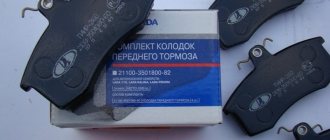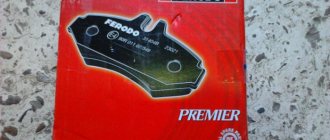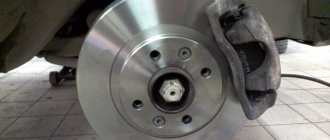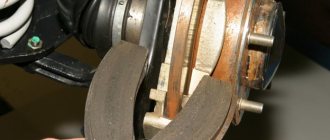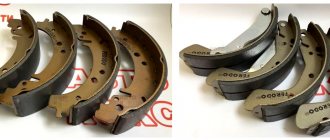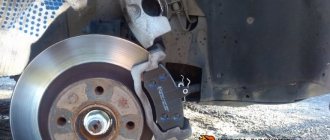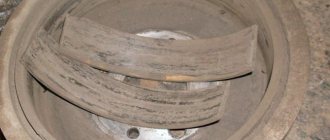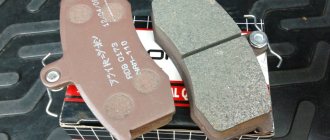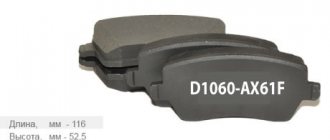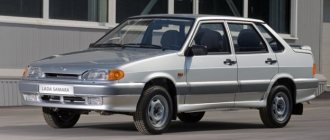When the time comes to replace brake pads in Largus, many Largus drivers begin to think about what kind of pads are installed on their car.
Surely they immediately turn to the Internet. And this is where difficulties may arise. Online stores offer brake pads for 8-cl and 16-cl engines, with and without ABS. The question involuntarily arises: “Which ones to choose?”
In order to accurately purchase the desired type of pads, I advise you not to be lazy, remove one wheel, look at the serial number of the part and use it to buy or order on the Internet. Better yet, check on both wheels. Otherwise, you risk missing.
You can also be guided by the appearance of the caliper. So on my 8-valve valve the following type of caliper is installed:
Looking ahead, I will say that it comes with pads with catalog number 410602192R .
Brake pads for Lada Largus
When purchasing brake pads for a Lada Lagrus, the car owner acquires not just the necessary consumables. The quality of the selected pads greatly affects the safety and sometimes the life of the car owner and passengers. Properly selected pads will be able to stop the car in time, without leading to an emergency.
Signs of pad wear
The problem with all spare parts whose work is based on interaction with other elements of the machine due to friction is inevitable and rapid wear. The same can be said about the brake pads, on which the pistons of the brake cylinders press. As a result, friction between the pads and the brake discs occurs. It is worth considering that the front brake pads wear out about twice as fast as the rear ones.
Their wear can be judged by the following signs:
- When braking, an unpleasant sound appeared: squealing or creaking.
- When stopping suddenly, noise and beating are felt.
- The time required for braking has increased.
- Inappropriate behavior of the brakes: fast or, conversely, slow operation.
If the above symptoms appear, the brake pads most likely need to be replaced.
Factors directly affecting wear
The service life of the pads, provided that the remaining components of the brake system are in good condition, can be influenced by several factors:
- Loading the machine. When constantly transporting cargo in the trunk of a car, the load during braking on the front brake pads is reduced, and accordingly the rear pads will wear out faster.
- Driving style. Non-aggressive driving significantly reduces the load on the brakes and directly on the pads. This affects the increase in service life of the friction layer on the pads.
- Driving mode. Driving in the city with its intersections and traffic lights, when you have to brake often, adversely affects the pads and contributes to their rapid wear.
- The presence of an ABS system, which promotes uniform wear of all pads.
Pad characteristics
The main working material in all pads is the friction base attached to the metal part of the pad. Their characteristics largely depend on its composition. The use of different materials in the manufacture of the friction layer is due to the achievement of a certain compromise.
A material that promotes better heat transfer and generally effective braking will be noisier. Using a softer material that reduces braking noise will cause it to wear out faster. Therefore, many components with different properties can be used in the friction layer.
For example, metal oxides improve friction; the use of graphite makes it impossible for the pad to stick to the disc. And the use of asbestos substitutes strengthens the layer.
Another important element is the glue that attaches the friction layer to the metal base of the pad. It must withstand vibration and thermal effects for quite a long time.
Currently, there are four types of friction linings:
- Semi-metallic. Here, up to 65% of components are used: copper, iron powder or steel wire with the addition of graphite to improve friction. Possessing high heat transfer, such linings wear out quickly and are noisy.
- Overlays made from organic ingredients (nonasbestos). They may be based on: carbon, glass, rubber, Kevlar - reinforced with high-temperature resins. Their advantage is softness, which helps reduce noise. The downside is a significant release of dust during friction and rapid wear.
- Low metal. In them, no more than 30% metal components are added to the organic components to improve heat transfer and friction. Their negative aspects are noise and the formation of dust particles.
- Ceramic linings. The friction material uses ceramic fibers to which a filler with a minimal content of copper or metal particles has been added.
Choosing pads for Lada Largus
It is necessary to select brake pads for a specific model and type of brakes in accordance with the manufacturer's recommendations.
Lada Largus has a rear drum brake mechanism. The following pads are suitable for it.
Drum pads Renault 7701210109t. Manufactured under strict quality control of the manufacturer. They have a mounting lever for the parking brake and are wear-resistant. Installed on cars with ABS.
TRW GS8780 - pads produced in Germany by the TRW corporation under the Lucas brand. Analogue 7701210109. Meets all ISO standard requirements and provides reliable braking. Also equipped with a mounting lever for the handbrake cable.
The following brake pads can be used as front brake pads.
Renault 410608481R - pads produced at the plant in Italy. They are characterized by good heat transfer and no noise, which is achieved by side bevels on the friction material.
Their analogues are the three types of pads described below:
- SANGSIN SP1564. Another solid pads made in Korea, which have good heat dissipation and excellent grip on the disc.
- TRW Lucas GDB3332. The pads are coated, which significantly reduces their grinding-in time and performs well during emergency braking. Side bevels contribute to the silent operation of these pads.
- Textar 2397301. Pads from a German manufacturer, almost silent, allowing comfortable braking. The best option for ventilated discs.
Renault 7711130078, 410602192R. Original pads produced in France. They are distinguished by a decent service life and the absence of noise when braking.
The following pads can be distinguished from analogues:
- ATE 13.0460-2834.2. Pads equipped with solid linings that can withstand high friction temperatures. Manufactured in Germany under the ATE brand according to its own quality standards, which exceed the requirements for products of this type.
- Bosch 0986467720. Produced at the Bosch Corporation plant in India in compliance with all regulations. The distinctive quality of this product is its noiselessness. A transverse slot on the pads helps remove dust.
- Delphi LP885. Manufactured in the UK, these pads are quiet and produce little dust thanks to the cross-slot design.
- Sangsin Hi-Q SP1243. Inexpensive pads from Korean manufacturers are characterized by a low noise level and good braking quality thanks to a transverse groove in the middle of the friction layer.
- Textar 2146304. Pads from German suppliers who have proven themselves in the production of high-quality consumables. They are distinguished by a fairly decent service life.
- TRW Lukas GDB400. The friction layer of these pads promotes soft braking, and the transverse slot in the middle minimizes their noise.
Your peace of mind and safety largely depend on which pads are installed on the Lada Lagrus brakes. Therefore, the choice of these “consumables” must be treated carefully and rationally.
- Published by: Pavel Ivanov
- Date: Saturday, November 28, 2015
Source: https://largus-shop.spb.ru/helpful/item/2666-tormoznye-kolodki-dlya-lada-largus
2283-14-02-08 (Copy)
Similarly, we replace the pads on the other side of the Lada Largus car. After replacing the pads, press the brake pedal several times to set the gaps between the pads and discs. We check the fluid level in the tank and, if necessary, bring it up to normal.
During operation, the surface of the brake disc becomes uneven, as a result of which the contact area of the new, not yet worn-in pads with the disc decreases
Therefore, during the first 100 km after replacing the pads, until the new pads have broken in, be careful, as the car’s braking distance may increase. In this case, the pads may become hotter than usual, up to the appearance of light smoke and odor, especially in hot weather
Replacing front brake pads on Lada Largus: photos and videos
The braking system is an integral part of vehicle safety. First of all, this concerns the serviceability of the Lada Largus brake pads. The choice of these products should be approached responsibly, because you cannot skimp on safety.
Video of replacing front brake pads on Lada Largus:
Front brake pad replacement process
In order to begin the process of replacing the front brake pads, you will need tools, namely: a wheel wrench, keys 13 and 15, as well as pliers.
So, let's get straight to the process:
- First you need to remove the front wheel.
- We recess the working piston of the caliper. This can be done using a flat blade screwdriver.
- On the caliper, it is necessary to loosen the fastenings of the guide pin from below.
Fastening pin - We remove the finger by unscrewing it.
- Lift the caliper up and disconnect it from the disc.
Without caliper and pads - First we remove the outer block, and then the inner one.
- Remove the upper and lower caliper springs.
- We install new pads in reverse order.
New pads installedThe process for replacing rear brake pads is similar.
The replacement procedure with and without the ABS function is the same. The only difference is that when replacing, the speed sensor is removed and inserted back.
Causes of malfunction
The reasons why it is necessary to change the front brake pads are:
- Degree of wear. The service manual states that the products must be replaced when the thickness of the friction part is less than 2 mm. But, as practice shows, the majority of motorists begin to change them when the level of wear becomes 1.5 mm. Comparison of the thickness of old and new brake pads
- Broken pad. At the same time, a sound is created, as if something got into the block and is interfering. This malfunction occurs when the quality of the product is poor. The pad is worn out critically, it begins to “eat” the disc
- Another indication that the pads need to be replaced is a squealing sound from the front of the wheels when braking . This is a critical level of wear.
2283-14-02-08 (Copy)
Similarly, we replace the pads on the other side of the Lada Largus car. After replacing the pads, press the brake pedal several times to set the gaps between the pads and discs. We check the fluid level in the tank and, if necessary, bring it up to normal.
During operation, the surface of the brake disc becomes uneven, as a result of which the contact area of the new, not yet worn-in pads with the disc decreases
Therefore, during the first 100 km after replacing the pads, until the new pads have broken in, be careful, as the car’s braking distance may increase. In this case, the pads may become hotter than usual, up to the appearance of light smoke and odor, especially in hot weather
About what front brake pads are installed on the Lada Largus
When the time comes to replace brake pads in Largus, many Largus drivers begin to think about what kind of pads are installed on their car.
Surely they immediately turn to the Internet. And this is where difficulties may arise. Online stores offer brake pads for 8-cl and 16-cl engines, with and without ABS. The question involuntarily arises: “Which ones to choose?”
In order to accurately purchase the desired type of pads, I advise you not to be lazy, remove one wheel, look at the serial number of the part and use it to buy or order on the Internet. Better yet, check on both wheels. Otherwise, you risk missing.
You can also be guided by the appearance of the caliper. So on my 8-valve valve the following type of caliper is installed:
Looking ahead, I will say that it comes with pads with catalog number 410602192R .
Brake pads for 8-cl Largus
The front brake pads on 8 and 16 valve cars are different from each other. It doesn't matter whether the car has ABS or not .
The assortment of many online stores includes the following numbers of front pads for Largus - 410608481R (without ABS) and 410602192R (with ABS). It is often not clear from the description what characteristics they have and how they differ from each other. And then many take as a guide the presence or absence of ABS or antennae on the pads on the car.
What does the VAZ Largus catalog tell us? Let's get a look. Go to the “Chassis” section, then “Caliper”.
In both pictures we look at the appearance of the pads and the catalog numbers. So they don't correspond to each other.
Pads with number 410602192R look like this:
Pads with number 410608481R look like this:
If you have an 8-cl. car, then I do not advise you to buy pads with number 410608481R, since they fit on a 16-cl. car, as well as on a Largus van.
On the 8 valve, original pads from Renault are installed under numbers 410602192R, 7711130071.
The following analogues are suitable:
— Korean SANGSIN SP1243
— BOSCH 986467720
- TRW GDB1465
I personally installed the Korean SANGSIN SP1243, cheaper and no worse than the original ones. During grinding in (about 150 km) there was a rustling noise when braking at low speeds. Then the rustling went away. At the time of writing this post, the pads had covered approximately 1,500 thousand. No squeaks, squeaks or other sounds were noticed, even in wet weather.
Here is the original packaging and appearance:
For the condition of the pads after 20 thousand mileage, see the article “Changing the pads on Largus.”
Brake pads for 16-cl Largus and van
With a high degree of probability, pads with number 410608481R will fit the luxury Largus. Also available TRW 8200 432 336
For a one hundred percent guarantee, it is recommended to check the pads installed directly on your car.
It is worth noting that the original pads are hard and wear down the brake disc well. You can verify this if you delay replacing them. At 30 - 40 thousand, grooves appear on the discs, as a result they will need to be grooved or replaced. Therefore, at least when changing shoes, check the condition of the brake pads and replace them in a timely manner.
Happy shopping everyone!
Other articles
Source: https://bakstrer.ru/kolodki_na_largus.html
Replacement procedure
First of all, drivers should know that such pads are replaced in pairs. Experts do not recommend doing this separately, because this can lead to destabilization of the entire car during a gradual or sudden stop. However, only the front elements of the system of the same name require frequent attention, although in many ways everything is justified by a specific malfunction.
Step one
The procedure for replacing the pads is carried out only in a set of 4 parts, 2 pieces on each side. First of all, you should check the brake fluid level in the tank of the corresponding cylinder. If it approaches the maximum, then the fluid needs to be pumped out, because after installing new pads this level rises significantly.
Step two
Next, the wheel bolts are loosened, from which the replacement of the pads begins. The corresponding part of the car is raised with a jack, reliable supports are installed and the wheel itself is removed. Using a screwdriver, the existing pads are removed from the disk, that is, the piston is pressed all the way into the bottom of the working cylinder.
How to change brake pads on a Lada Largus - Za Rulem magazine
Set of pads front: 650–900 rear: 700–1300
Set of pads front: 650–900 rear: 700–1300
Before removing the brake drum, lower the parking cable lever all the way.
To remove the drum, the pads need to be brought together. To do this, use a slotted screwdriver to rotate the ratcheting nut of the automatic clearance adjustment mechanism through the threaded hole in the brake drum, reducing the length of the spacer bar. Rotate the ratchet nut by its teeth from top to bottom.
To remove the drum, the pads need to be brought together. To do this, use a slotted screwdriver to rotate the ratcheting nut of the automatic clearance adjustment mechanism through the threaded hole in the brake drum, reducing the length of the spacer bar. Rotate the ratchet nut by its teeth from top to bottom.
Use a hammer and chisel to knock down and remove the protective cap of the wheel bearing. Use a 36mm socket to unscrew the hub bearing nut.
Use a hammer and chisel to knock down and remove the protective cap of the wheel bearing. Use a 36mm socket to unscrew the hub bearing nut.
Remove the brake drum assembly with bearing.
Remove the brake drum assembly with bearing.
Holding the support post of the front block, use pliers to turn the strut spring cup until the groove in the cup aligns with the strut shank
Holding the support post of the front block, use pliers to turn the strut spring cup until the groove in the cup aligns with the strut shank
Why the handbrake does not work on the VAZ 2107
Like any other part or mechanism, the handbrake cable tends to wear out and become unusable. The parking brake on the VAZ 2107 is activated using a lever located in the middle part of the car between the driver and passenger seats.
We recommend: Why doesn’t the heater on a Niva Chevrolet blow at your feet?
Periodically, the handbrake cable should be tightened, as it becomes weakened, which leads to a decrease in the efficiency of the device. The reasons why the handbrake on the “seven” may not function are due to the following factors:
- Excessive cable stretch.
- Damage to the cable.
- Malfunction of the brake mechanism in the rear wheel drums.
During prolonged use of the car, when the handbrake is constantly used, owners are faced with the need to periodically restore the cable tension. Over time, the device in question stretches, and there is nowhere to tighten it. The only way out of the situation is to exchange the product for a new one. It is recommended to carry out work on replacing the handbrake cable in an inspection hole, but you can do without it.
Changing the handbrake cable
Replacing the handbrake cable on a VAZ 2107 car begins with the fact that it is first necessary to dismantle the brake drums of the rear wheels
After dismantling the brake drums, you should pay attention to the condition of the rear brake pads and working cylinders. The presence of traces of fluid leakage will indicate that the mechanisms also need repair
Each owner of his car decides individually when it is necessary to change the handbrake cable. It all depends on the degree of wear of the cable. The procedure for replacing the parking brake cable is divided into 2 stages: dismantling and installation, as well as adjusting the tension.
The replacement algorithm is as follows:
- After the rear wheels and brake drums are removed, you need to go down into the inspection hole and find the tension adjusting rod. This rod is equipped with a spring, which must be removed using a screwdriver.
- Both nuts are unscrewed, after which the adjustment bar is removed. Next, the rear and front handbrake cables are dismantled.
- Using a wrench, you need to unscrew the two nuts securing the two brackets. These brackets prevent the cable from falling. There are screws under the nuts that prevent them from unscrewing on their own.
- After this, you should remove the rear brake drums and remove the springs that secure the brake pads. The pads can also be replaced if they show excessive wear.
- Next, you need to pull the cable to disengage it from the bracket against which it rests.
- The brake pads are removed. There is no need to remove both pads on the wheel. To replace the rear cable, you only need to remove one rear brake pad.
- Now you should unscrew two fixing bolts from the back of the brake shield of both wheels. With their help, the cable tip is fixed. After unscrewing these two bolts, you should pull the cable, as shown in the photo below.
- Using a 10mm wrench, you need to unscrew the front cable mounting brackets. After unscrewing the bolt, carefully remove the roller. To remove the roller, you need to roll it forward in the direction of the tip.
- To remove the front part of the device, you need to pull on the product to remove it from the bracket and intermediate support structure.
- After this, you need to get out of the hole and go into the car interior. When performing work, the handbrake must be in its lowest position. Inside, unscrew the two screws securing the handle trim.
- There are 4 bolts under the cladding that need to be unscrewed. After unscrewing them, you will need to remove the handle along with the front cable.
- To disconnect the cable mount from the handle, you will need to use pliers to remove the small cotter pin that secures the device to the handbrake handle.
- After this, the device can be completely removed from the car and a new cable installed in its place. The installation process of both products is carried out in the reverse order of removal. After this, you should secure them and begin the tension adjustment procedure.
Adjusting the hand brake VAZ 2107
Adjustment of the handbrake should be performed not only periodically when the parking brake is lost, but also after replacing the cable. In order to adjust the cable tension, you will need to take the following tools:
- pliers;
- two keys for 13;
- a can of WD-40 lubricant.
Brake pads – Page 67 – Lada Vesta Club
I made a selection from an online store. The choice is simply huge. For some there are already reviews, for others there are not.
Requested article number 82 00 432 336
RENAULT 82 00 432 336 PADS PER LARGUS 16KL RUB 2,161 RENAULT 82 00 432 336 Front brake pads LARGUS 16cl 2,342 rub.
Analogs
ADR VAZ/GAZ/UAZ website: www.kolodka-fm.ru Country: Russia
ADR011311 BRAKE PADS FRONT ADR 011311 Lada Vesta,Largus dv.1.6 (16cl),Duster,Nissan Almera IV (12-) “ADR” 315 rub. Amiwa Country: Korea Website: AMIWA24.RU cd1261 REAR DISC BRAKE PADS SPEED STOP 608 rub.
ASIMCO Country: USA. Website: www.asimcousa.com, www.asimco.com
KD7785 Disc brake pads KD7785 834 rub.
ASP Country Türkiye. Website: www.aspmensan.ru
K270201 Brake pads front Lada Largus 16V 378 rub.
AYWIparts Country Korea. Website: www.aywiparts.ru
AW1810503 Brake pads NISSAN Tiida 07-; Micra 03-; Note 06-; RENAULT Clio 05 - front AYWIPARTS, Duster 1.6, Largus 16-cl., Suzuki Swift 544 rub.
Ferodo Country: France. Ferodo is an English brand Website: www.ferodo.co.uk
FDB1617 Pads RENAULT DUSTER / LADA LARGUS, FDB1617_=D1261 [41060AX625]! Nissan Micra/Note, Renault Clio 1.0-1.6 03 RUR 1,070 FIT Country: Japan, Taiwan and South Korea. FP1491 Brake pads SUZUKI SWIFT 05-/OPEL AGILA 07-/NISSAN MICRA 10- front 886 rub. Francecar Country: France Website: francecar-parts.com. Factories are located in France, Turkey, Romania, Taiwan, China. FCR210330 Front disc brake pads. RENAULT (Duster 4X2, Kaptur 4×2), LADA (Largus,VESTA) NISSAN (Micra III (K12), Note (E11)) NISSAN TIIDA (C11X) 09.07-, NISSAN NOTE (E11) 395 rub.
Useful tips
The first thing that worries every motorist during the next technical inspection of the caliper and brake lining is what its maximum wear margin is. Less than 1.5 mm thickness of the friction lining should not be allowed
It is also very important, when changing pads, to also measure the degree of wear of the brake disc.
Lada Largus brake pads can last up to 50 thousand km. mileage during quiet driving. Aggressive driving style greatly reduces the actual life of the product. Therefore, it is better to monitor the degree of their wear every 10-20 thousand km. mileage
It is important to understand which structural elements are responsible for reliable braking. If the car’s braking distance has noticeably increased and obvious signs of a malfunction cannot be determined, the following possible problems can be identified:
- If the wear of the friction linings is within normal limits, but the brakes are working frankly poorly, check the condition of the brake fluid. Perhaps it absorbed too much moisture and lost its performance characteristics;
- if the brake pads are worn unevenly, this is a clear sign of problems with the caliper, in particular, acidification of the guides and working cylinders. It is also necessary to inspect the caliper;
- Excess oil in the caliper guides can get onto the brake disc, which will also increase the distance required to brake the car.
Front brake pads Lada Largus
The brake system in any car requires timely inspection for wear of its components, which implies the need for further replacement of all failed parts.
These actions cannot be neglected, since the safety of the driver and his companions directly depends on the effectiveness of the entire braking unit.
Such statements are also typical for the domestic Lada Lagrus station wagon, which today will be the “hero” of our material.
Signs of pad wear
The instruction manual for a Lada Lagrus with a 16-valve engine, as a rule, contains very detailed information regarding this issue.
It also displays all the parameters that characterize the front brake pads.
The degree of wear of these consumable components is determined by the residual thickness of the friction linings, which come into direct contact with the discs or drums during braking.
In this regard, gradual and natural abrasion occurs. Many experts are inclined to believe that front brake pads are the most intensively worn consumables. Here you should not wait until the end of the scheduled service life, expressed in mileage (20-30 thousand km).
km), and observe the level of wear with sufficient frequency, and then make a decision on replacement. It is no secret that failed front brake pads provoke increased wear on the working surfaces of discs or drums.
Replacing the front brake pads in a Lada Lagrus car is very expensive, so it is not recommended to “bring” the car to this condition.
Some of the most common signs of wear include the following:
- the appearance of a squeak when the brake is activated;
- spontaneous change in direction of movement from a straight trajectory;
- the brake pedal vibrates when pressed;
- it is impossible to lock the wheels with the handbrake, even with the drive cable fully tensioned;
- reducing the thickness of the disc beyond the limit of 21.8 mm;
- the thickness of the friction linings on the pads has approached the critical value of 2 mm;
- the working surface of the pads is dotted with grooves and chips.
Regular inspection followed by replacement of worn-out components allows you to eliminate the manifestation of these factors.
How to replace?
Let us note an important point - replacing the pads in a Lada Lagrus with a 16-valve engine should only be done in pairs. Consumables replaced individually during sudden braking can cause the vehicle to skid or drift. The front elements require more frequent attention because the design directs more braking force to the front axle.
Procedure
- First, we purchase suitable pads. The set of front consumables consists of 4 pieces (2 pieces on each side).
- We control the brake circuit fluid level in the corresponding reservoir (under the hood) using the marks on its body.
If the level reaches the maximum level, then it will need to be taken with a syringe, since after installing the new pads there will be a natural (due to the greater thickness of the pads) rise. - We loosen the tightening torques of the bolts of the front wheel from which the replacement is supposed to begin.
- We hang this part of the car with any available device designed for this purpose. We remove the wheel. Don't forget about safety supports (if a jack is used).
- We take a screwdriver, which we insert between the pad and the disc, and with a pressing force we move it towards the cylinder.
The rod is hidden in the cylinder, which provides free space for removing the pads. - Now we loosen the tightening torque of the caliper bracket, and then move it up.
- We remove the old pads.
- We inspect the springs of the clamping mechanism for their deformation and breakage. If this fact is obvious, then we change it.
- We check the integrity of the rubber covers on the caliper guides. We lubricate the guides themselves with a special compound. This will prevent them from souring, and the bracket will move freely during the exit or entry of the piston.
- We carefully clean the seats for new pads.
- The linings on “fresh” pads are thicker than on old products, so the piston must be recessed to the full extent of its stroke. This will provide enough space for the correct installation of consumables.
- After installation, perform the assembly process in reverse order.
Replacement of front brake pads is completed.
We repeat the entire list of these manipulations on the other side of the LADA Largus.
If there is a need to replace the rear pads, then the principle of operation is similar, with the exception of some nuances.
How to operate the car after replacing the pads?
After installing new pads in a Lada Lagrus with a 16-valve engine, you should not rush to drive onto roads with heavy traffic.
The first presses on the brake pedal can cause inefficiency of the entire system, because consumables require time to grind into the working surfaces of the discs. Contact during this period does not occur over the entire surface, which explains the low performance of the pads.
Over time, the situation will normalize. To properly “break in” the LADA Largus pads, we recommend choosing road sections with no heavy traffic. Once the process of grinding the pads to the discs is complete, you can observe the effectiveness of the brakes.
At first, we recommend avoiding sudden braking to prevent excessive heating of the new linings. In “quiet” mode you should travel at least 100 km.
Let's sum it up
Since the LADA Largus brake system has a significant impact on the safety of movement, the elements require increased attention and timely replacement of the front brake pads.
We do not recommend allowing excessive levels of wear on the working surfaces. The specified consumable components that have become unusable should be promptly replaced.
Buy products only of decent quality, which will allow you to gain confidence in the stable functioning of the brake unit only in normal mode, but also in emergency situations.
Source: https://ZamenaRenault.ru/largus/elektrika-i-tormoza/kolodki-tormoznye-perednie.html
labavto.com
The vehicle's braking system must always be in good working order to ensure the necessary safety. Brake pads (BC) are constantly subject to significant loads, so their elements wear out quickly, including the linings and drums on the rear wheel. Using step-by-step instructions, you can replace the TC in Largus yourself in a garage.
When to change pads
Manufacturer of manual car Lada Largus recommends changing the TC after 30,000 km. The following reasons may shorten the replacement period:
- long-term operation without preventive inspection;
- difficult conditions in which the car is used;
- mechanical damage to the rotary cam, caliper, which caused deformation of the linings and, as a consequence, the appearance of creaking noise;
- harsh climate;
- low quality of consumables or violation of technology during their installation;
- aggressive driving style of the driver;
- lack of fuel fluid in the master cylinder expander, damage to the brake pipes;
- The actuator cylinders are jammed.
To keep the vehicle in working condition, the brake system should be diagnosed every 15,000 km. It is better to inspect when the season changes. It is convenient to inspect the pads along with changing tires from summer to winter, and vice versa.
The TC is replaced if the maximum permissible wear is 1.5 mm. If you continue to drive, the rubber seals installed on the pistons may deteriorate. Depressurization will cause brake fluid to leak, which will lead to a decrease in the efficiency of the brake system. It is recommended to replace at a thickness of 5-7 mm.
The Lada Kalina does not have a digital sensor, so you have to measure the thickness of the body of the lining manually. To do this, you need to dismantle each wheel and measure the thickness of the lining with a caliper. Alternatively, you can turn the steering wheel all the way to the left, and then to the right and estimate the thickness by eye to avoid removing the wheels. But this method is only suitable for the front pair. The rear ones definitely need to be removed.
The pads must also be replaced if there is a significant layer of oil on the surface of the linings, mechanical damage appears on them, scratches, chips, peeling, chipping and charring.
You can determine the need for replacement by the following signs:
- Reduced braking quality due to increased brake pedal travel.
- Increased handbrake travel. Let’s say that when setting the standing brake you had to click 3-4 times, the number of clicks increased to 5-7. With the hand brake on, the car continues to roll down any hill. Maybe the reason is a stretched cable, but check the pads.
- During braking, extraneous sounds appear: knocks, squeaks, noises. Vibration may occur, but the cause may be disc deformation. You need to turn the disk and watch its beats. If the figure eight is visible, it is clear that the disk needs to be changed.
- Dust condition. If you look under the discs, you can see dust and deposits formed from the dust released during braking. If it's dark in color, that's okay. If there are metal inclusions, this indicates that the disc is scratched and the TC needs to be replaced.
Brake pad replacement process
TCs are replaced only as a set on both sides to avoid uneven braking and the car skidding to the side.
To carry out the procedure, you need to prepare the following tools:
- two mounting blades;
- flat screwdriver;
- pliers;
- bar;
- chisel;
- hammer;
- a set of keys.
Before starting work, place the machine on a flat horizontal surface.
Changing the front TCs
We place wooden supports under the rear wheels or turn on the handbrake to prevent the vehicle from moving. Further work is carried out step by step:
- We look at the fuel fluid level in the expander. If it is at the maximum level, use the existing device to pump out the excess liquid. This is necessary so that when the piston is immersed in the cylinder, the fuel fluid does not flow from under the expander cap.
- Using a handy tool, we straighten the curved edges of the lock washer of the lower mounting bolt.
- Fixing the finger by the hexagon, unscrew the lower mounting bolt. and remove it along with the washer.
We take out the TC from the guide. If they are pinched by the pistons, move the pistons back by inserting a flat-head screwdriver between the disc and the valve body.
- After removing the TC, we clean all elements from dirt, deposits, and rust. We check for leaks of the fuel fluid and the integrity of the boots on the pistons. We change it if necessary. If there is a leak, we eliminate the cause.
- Before placing replacement parts, the piston must be recessed into the cylinder to the maximum. This can be done in two ways. 1st: we recess the piston using large pliers, while the body and cylinder remain raised.
2nd: we mount it inside the TC on the seat, move the bracket to its usual position. We insert the mounting tool or the blade of a screwdriver into the slot on the caliper and, resting against the disc, lower the piston into the cylinder.
- Having installed the new parts, lower the bracket with the cylinder and screw in the lower mounting bolt, securing it with a lock washer to prevent it from unwinding.
- After completing the replacement, depress the brake pedal a couple of times to establish gaps between the discs and the brake pedal.
- Screw on the wheel.
- We normalize the level of fuel fluid.
Replacing front brakes on Lada Largus.
